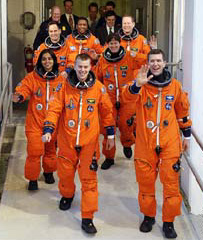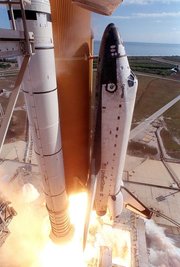STS-107
|
|
| Mission Insignia | |
|---|---|
| Missing image Sts107_flight_insignia.jpg image:Sts107 flight insignia.jpg | |
| Mission Statistics | |
| Mission: | STS-107 |
| Shuttle: | Columbia |
| Launch Pad: | 39A |
| Launch: | January 16, 2003 9:39 a.m. CST |
| Last transmission: | February 1, 2003 7:59:32 a.m. CST |
| Landing: | Scheduled for February 1, 2003 8:16 a.m. CST |
| Duration: | 15 days, 22 hours, 20 minutes, 32 seconds |
| Orbit Altitude: | 166 nautical miles (307 km) |
| Orbit Inclination: | 40.3 degrees |
| Distance traveled: | 6.59 million miles (10.6 million km) |
| Crew photo | |
 | |
STS-107 was a space shuttle mission by NASA using the Space Shuttle Columbia, launched January 16, 2003. The seven-member crew was killed on February 1, 2003, when the shuttle disintegrated after reentry into the Earth's atmosphere. See Space Shuttle Columbia disaster for further details.
The mission of the STS-107
This was a multi-disciplinary microgravity and Earth science research mission with a multitude of international scientific investigations conducted continuously during 16 days in orbit.
One of the experiments, a video taken to study atmospheric dust, may have detected a new atmospheric phenomenon, dubbed a "TIGER" (Transient Ionospheric Glow Emission in Red) [1] (http://www.newscientist.com/article.ns?id=dn6897)
On board the Columbia was a picture by fourteen year old Petr Ginz, the editor-in-chief of the magazine Vedem, who depicted what he imagined the Earth looked like from the Moon, while he was a prisoner in the Terezin Ghetto. The picture was destroyed in the disaster.
Crew
- Rick D. Husband (2), Commander
- William C. McCool (1), Pilot
- David M. Brown (1), Mission Specialist
- Kalpana Chawla (2), Mission Specialist
- Michael P. Anderson (2), Payload Commander
- Laurel Clark (1), Mission Specialist
- Ilan Ramon (1), Payload Specialist - Israel Space Agency
( ) indicates number of spaceflights each crew member completed.
Mission Parameters
- Mass:
- Orbiter Liftoff: 119,615 kg
- Orbiter Landing: 105,593 kg
- Payload: 14,553 kg
- Perigee: 270 km
- Apogee: 285 km
- Inclination: 39.0°
- Period: 90.1 min
Crew members aerospace history
- Rick D. Husband, Commander. A U.S. Air Force colonel and mechanical engineer, who piloted STS-96 during the first docking with the International Space Station. Husband logged more than 3,800 hours of flight time in more than 40 different types of aircraft and served as a flight instructor and a test pilot. He reported to Johnson Space Center in Houston, Texas, in March 1995.
- William C. McCool, Pilot. A U.S. Naval Commander, In 1986, McCool began his flying career with the Navy. He flew 24 different aircraft, including the EA-6B Prowler, and had more than 400 carrier landings. He became a test pilot in 1992. The pilot served on two aircraft carriers, the USS Coral Sea and the USS Enterprise, and had more than 2,800 hours of flight time. McCool became an astronaut candidate and reported to Johnson Space Center in Houston, Texas, in 1996.
STS-107_crew_in_orbit.jpg
- David M. Brown, Mission Specialist. A U.S. Navy captain trained as an aviator and flight surgeon. Brown worked on a number of scientific experiments. In 1988, Brown became the only flight surgeon to be selected for pilot training in a 10-year period. He completed his training and became a naval aviator in 1990, ranking first in his class. He logged 1,700 hours of flight time in high-performance military aircraft during his stint with the Navy. In 1996, his talents took him to NASA when he was selected as an astronaut candidate.
- Kalpana Chawla, Mission Specialist. Her path to become an astronaut began in Karnal, India. She was an aerospace engineer Her first flight was STS-87, the fourth U.S Microgravity Payload flight, on Space Shuttle Columbia from Nov. 19 to Dec. 5, 1997. She was a mission specialist and operated Columbia's robot arm. She returned to space in Jan. 16, 2003, aboard Columbia. She served as mission specialist during the 16-day research flight. The agency selected her as an astronaut candidate in December 1994, and she reported to Johnson Space Center in March 1995.
- Michael P. Anderson, Payload Commander. A U.S. Air Force lieutenant colonel and physicist who was in charge of the science mission. Anderson received a master's degree in physics in 1990 from Creighton University in Omaha, Neb. Anderson flew various models of the KC-135 and the T-38A aircraft, logging more than 3,000 hours of flight time. He also became an instructor pilot. In late 1994 when NASA selected him as an astronaut candidate. Anderson's first space flight occurred in 1998 when he flew as a mission specialist on Space Shuttle Endeavour during STS-89.
- Laurel Clark, Mission Specialist. A U.S. Navy commander and flight surgeon. Her path to becoming an astronaut included being a member of the U.S. Navy. During her time in the Navy, Clark became an undersea medical officer. While stationed in Scotland, she dove with divers and performed numerous medical evacuations from U.S. submarines. Later, she became a flight surgeon. Clark worked on a number of biological experiments.
- Ilan Ramon, Payload Specialist. A Colonel in the Israeli Air Force and the first Israeli astronaut. He fought in the Yom Kippur War in 1973 and graduated as a fighter pilot from the Israel Air Force Flight School in 1974. In 1981, he took part in the IAF mission that destroyed a nuclear reactor in Iraq. Over the next nine years, he gained experience in flying the A-4, F-16 and Mirage III-C aircraft, which included time training at Hill Air Force Base in Utah. Then, he attended the University of Tel Aviv from 1983 to 1987, where he earned a bachelor's degree in electronics and computer engineering. He then returned to flying for the air force. Ramon compiled more than 4,000 flight hours in Israeli military aircraft. In 1997 he was selected to be an astronaut, and he reported to Johnson Space Center in Houston, Texas, in 1998.
Insignia
The central element of the patch is the microgravity symbol, µg, flowing into the rays of the astronaut symbol.
The mission inclination is portrayed by the 39 degree angle of the astronaut symbol to the Earth's horizon. The sunrise is representative of the numerous experiments that are the dawn of a new era for continued microgravity research on the International Space Station and beyond. The breadth of science and the exploration of space is illustrated by the Earth and stars. The constellation Columba (the dove) was chosen to symbolize peace on Earth and the Space Shuttle Columbia. The seven stars also represent the mission crew members and honor the original astronauts who paved the way to make research in space possible. Six of the stars are five pointed, the other is six pointed like a Star of David, symbolizing the Israeli Space Agency's contributions to the mission.
An Israeli flag is adjacent to the name of Payload Specialist Ramon, who was the first Israeli to fly aboard the space shuttle.
Related articles
External links
- NASA's STS-107 Space Research Web Site (http://spaceresearch.nasa.gov/sts-107/index.html)
- Spaceflight Now: STS-107 Mission Report (http://spaceflightnow.com/shuttle/sts107/status.html)
- STS-107 Science Reports (http://microgravity.grc.nasa.gov/combustion/web/sts107_reports.htm)
- Press Kit (http://www.shuttlepresskit.com/STS-107/index.htm)
- NASA STS-107 Crew Memorial web page (http://spaceflight.nasa.gov/shuttle/archives/sts-107/memorial/index.html)
- Anti-Semitic shuttle conspiracy theories swamp the Internet (http://www.haaretzdaily.com/hasen/pages/ShArt.jhtml?itemNo=264824&contrassID=2&subContrassID=1&sbSubContrassID=0&listSrc=Y)
- Anti-Semitic groups promote Columbia conspiracy theories (http://www.adl.org/Anti_semitism/columbia.asp)
- Article describing experiments which survived the disaster (http://www.nasa.gov/missions/shuttle/experiment.html)
- STS107 Multimedia Website (http://www.chrisvalentines.com/sts107/index.html)
- Article: Astronaut Laurel Clark from Racine, WI (http://racine.wi.net/clark.php3)
| Previous Mission: STS-113 |
Space Shuttle program | Next Mission: STS-114 |

